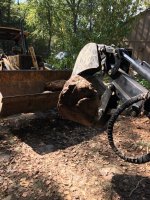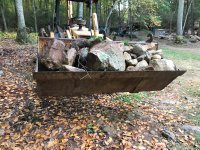OP
2manyrocks
Super Member
- Joined
- Jul 28, 2007
- Messages
- 8,668
Now you have me wondering how the PT design fares in hillside stability comparison to a compact track loader like a Kubota SVL-97 when used with a front rotary cutter? The Kubota is outside of my budget to buy, but can be rented for $1850 a week plus delivery. However, I'm not too keen on renting $100k of equipment that could turn over or loose a track on a hillside. What are your thoughts on how a PT fares in comparison?I started out with the smallest Power Trac they make, the PT018 to do brush cutting in an area that has a tremendous amount of rocks and ledge. I tried every brand of tractor I could find and the Power Trac was the only one that hit most of the correct requirements. Most importantly front attachment (HD mower) on a loader {not a 3pt hitch like Antonio Carraro, or a <2' lift on a Steiner or Ventrac}, 4x4, power steering, good ground clearance or impervious to underside damage, and agile. The 018 was near perfect, so much so that I tried the 1430 as I wanted a larger size and the diesel. It worked so well I looked into the 1445 and 1460 and ended up with the 1460. The hill climbing is good. I do wish it could lock out the differential action hydraulically like my Moffett 3-wheel fork lift. It could be added, since it is just hyd valves. I think it would make it a birds nest of entangled hoses, so I haven't done it.
On a steep climb with loose ground, you will get wheel spin, especially from the front wheels. However (the diesel (1430 up) PTs have a draft feature that proportionally directs oil to the lift cylinders as wheel torque is increased, adding more weight to the front tires.
The negative of the somewhat reduced traction of the PT (when compared to a 4x4 conventional tractor) is more then offset by the best stability I have experienced! Not to get too complicated, but conventional tractors are stabilized by the rear axle/tires only, not the front. Remember the front axle on a conv tractor is a pivot point and does not assist in keeping the tractor upright until one rear wheel is up in the air with the tractor leaning over-contacting the stops on the front axle. The PT along with being lower profile, has a different type of pivot at the center articulation joint. This works better as the front tires are rigidly attached to the complete front half of the tractor (with loader arms) and when you overload a PT, and the rear lifts in the air, that is when the rear portion will tilt over (like a conventional tractor only reversed). On the conventionally tractor with the loader raised and overloaded with one rear tire elevated, it now tilts the loader off to the side potentially outside of the tread width compounding your chances of rolling the tractor. As explained, the PT is ridge to the front wheels and holding the same angle as the ground, only the rear tilts.
I don't know how much "seat time" you have had on tractors, but if enough to compare, you will love the stability of the PT.
I used my 1430 more then any other tractor period. I have some attachments that I interchange with the 1460 and just for reasons of economy, if the 1430 will do the job, I use it instead of the 1460 (it is a cost per hour of operation consideration for me).
Sorry to be long winded, but as you could probably guess, I would recommend the PT over anything else available. Then figure the size you need, and the features that come with it. 425-no draft and pretty small tractor, 1430-has manual 2-wheel park/emergency brake, 1445+ diesel durability.


